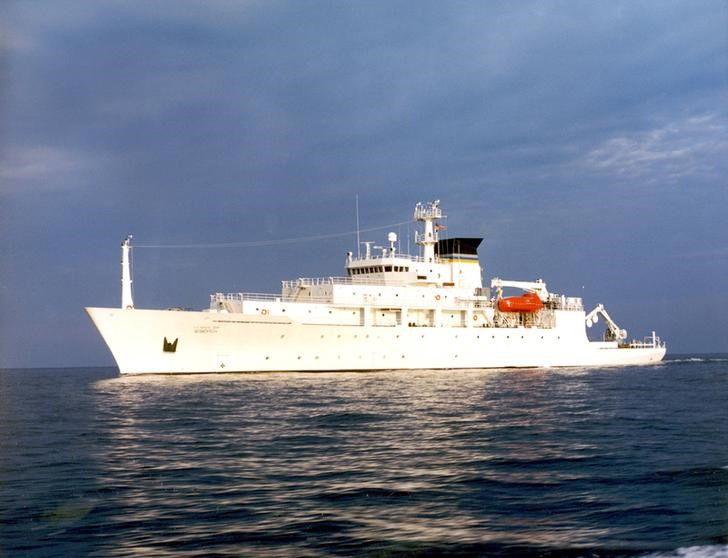Image: The oceanographic survey ship, USNS Bowditch, is shown September 20, 2002, which deployed an underwater drone seized by a Chinese Navy warship in international waters in South China Sea, December 16, 2016. Courtesy U.S. Navy/Handout via REUTERS
By Phil Stewart, Idrees Ali and Ben Blanchard
WASHINGTON/BEIJING (Reuters) – The United States expects China to return soon an underwater U.S. drone seized by a Chinese naval vessel last week, with one U.S. official telling Reuters the exchange could happen as early as Tuesday at an agreed location in the South China Sea.
China’s seizure of the unmanned underwater vehicle (UUV) triggered a diplomatic protest and speculation about whether it will strengthen U.S. President-elect Donald Trump’s hand as he seeks a tougher line with Beijing.
A Chinese warship took the drone, which the Pentagon says uses unclassified, commercially available technology to collect oceanographic data, on Thursday about 50 nautical miles northwest of Subic Bay in the Philippines.
The U.S. officials, who spoke on condition of anonymity, said talks with Beijing on the timing of the exchange were advancing, with two saying they expected the incident to be satisfactorily resolved “relatively soon.”
One of the officials added the exchange could take place in the vicinity of the disputed Scarborough Shoal in the South China Sea as early as Tuesday, local time, putting the handover potentially just hours away.
A U.S. destroyer would likely receive the drone, although the mechanics of the exchange were unclear.
Pentagon spokesman Peter Cook refused to offer any details at a news briefing, saying only that “conversations are ongoing … We’re working out the logistical details with Chinese officials”.
In Beijing, China’s foreign ministry said the Chinese and U.S. militaries were having “unimpeded” talks about the drone’s return.
The seizure has added to U.S. concerns about China’s growing military presence and aggressive posture in the disputed South China Sea, including its militarization of maritime outposts.
KEEP THE DRONE!
Trump, who takes office on Jan. 20, waded into the dispute on Twitter over the weekend, saying in a Tweet: “We should tell China that we don’t want the drone they stole back – let them keep it!”
Trump has previously threatened to declare China a currency manipulator and force changes in U.S.-Chinese trade policy, which he says has led to the greatest theft of American jobs in history.
Trump has also raised questions about the most sensitive part of the U.S.-China relationship: whether Washington would stick to its nearly four-decades-old policy of recognising that Taiwan is part of “one China.”
Asked about Trump’s comments, Hua said describing the drone as stolen was “completely incorrect”.
“The key is that China’s navy had a responsible and professional attitude to identify and ascertain this object,” she said. “If you discover or pick something up from the street you have to examine it and if somebody asks you for it you have to work out if it’s theirs before you can give it back.”
Cook called the seizure illegal and said Washington was using both military and diplomatic channels to secure the drone’s return. Pentagon officials have sought to be firm without escalating the incident.
Another senior U.S. official, speaking on condition of anonymity, said the somewhat muted U.S. response to the seizure, coupled with Trump’s abandonment of the Trans-Pacific Partnership trade agreement, Philippine President Rodrigo Duterte’s erratic policies and Malaysia’s corruption scandal, has caused some U.S. allies to worry increasingly about the possibility of a declining American commitment to the region.
The Philippines said it was troubling that the incident took place inside its exclusive economic zone (EEZ), saying it increased the likelihood of “miscalculations that could lead to open confrontation” very near the Philippine mainland.
DEEP SUSPICIONS
China is deeply suspicious of any U.S. military activities in the resource-rich South China Sea, with state media and experts saying the use of the drone was likely part of U.S. surveillance efforts in the disputed waterway.
The overseas edition of the ruling Communist Party’s People’s Daily said in a commentary on Monday the USNS Bowditch, which was fielding the drone and was set to pick it up, was a “serial offender” when it came to spying operations against China.
Ni Lexiong, a naval expert, Shanghai University of Political Science and Law, told Reuters he believed the Chinese navy probably had orders to take the drone.
But Ni said this is a very different incident from the 2001 intercept of a U.S. spy plane by a Chinese fighter jet that resulted in a collision that killed the Chinese pilot and forced the American plane to make an emergency landing at a base on Hainan.
“This is a much smaller incident, it won’t affect the overall picture of China-U.S. relations,” he said, adding that he did not expect China to seek an apology from the United States.
The 24 U.S. air crew members were held for 11 days before being released, souring U.S.-Chinese relations in the early days of President George W. Bush’s first administration.
(Additional reporting by Manuel Mogato in Manila and John Walcott in Washington; Editing by Lincoln Feast and James Dalgleish)
Copyright 2015 Thomson Reuters. Click for Restrictions.


